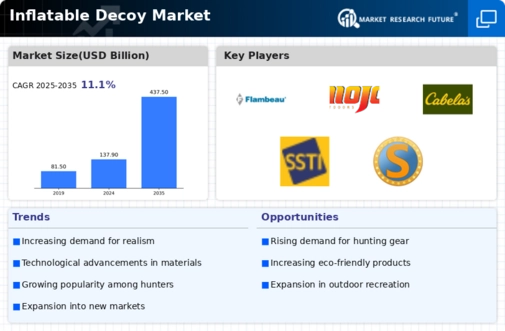Market Growth Projections
The Global Inflatable Decoy Market Industry is poised for remarkable growth, with projections indicating a market size of 137.9 USD Billion in 2024 and an anticipated increase to 437.5 USD Billion by 2035. This growth trajectory suggests a compound annual growth rate of 11.07% from 2025 to 2035, reflecting the increasing popularity of inflatable decoys among hunters and outdoor enthusiasts. The market's expansion is likely driven by factors such as technological advancements, rising demand for hunting accessories, and a growing awareness of wildlife conservation. These dynamics collectively contribute to a robust outlook for the industry in the coming years.
Expansion of Recreational Activities
The expansion of recreational activities contributes significantly to the Global Inflatable Decoy Market Industry. As more people seek outdoor experiences, the demand for equipment that enhances these activities, including hunting, has increased. Inflatable decoys serve as a vital tool for hunters, enabling them to attract game effectively. The market is expected to grow at a compound annual growth rate of 11.07% from 2025 to 2035, reflecting the rising participation in outdoor sports. This trend indicates a broader cultural shift towards outdoor recreation, which is likely to sustain the industry's growth as more individuals engage in hunting and related activities.
Rising Demand for Hunting Accessories
The Global Inflatable Decoy Market Industry experiences a surge in demand for hunting accessories, driven by an increasing number of outdoor enthusiasts and hunters. As hunting becomes a popular recreational activity, the need for effective decoys to attract game has intensified. In 2024, the market is projected to reach 137.9 USD Billion, reflecting a growing interest in innovative hunting gear. The use of inflatable decoys, which are lightweight and easy to transport, aligns with the preferences of modern hunters seeking convenience and efficiency. This trend suggests a robust growth trajectory for the industry as more individuals engage in hunting activities.
Increased Investment in Outdoor Sports
Increased investment in outdoor sports significantly impacts the Global Inflatable Decoy Market Industry. Governments and private organizations are recognizing the economic potential of outdoor recreation, leading to enhanced funding for related infrastructure and equipment. This investment not only promotes participation in hunting but also encourages the development of innovative products, including inflatable decoys. As the market evolves, the projected growth to 437.5 USD Billion by 2035 underscores the potential for substantial returns on investment in this sector. The influx of resources may also facilitate research and development, further enhancing the quality and appeal of inflatable decoys.
Growing Awareness of Wildlife Conservation
The Global Inflatable Decoy Market Industry is influenced by the growing awareness of wildlife conservation among hunters and outdoor enthusiasts. As individuals become more conscious of their impact on ecosystems, the demand for ethical hunting practices rises. Inflatable decoys, which minimize harm to wildlife compared to traditional methods, are increasingly favored. This shift towards sustainable hunting practices aligns with conservation efforts and promotes responsible engagement with nature. The industry's growth may be further supported by educational initiatives that emphasize the importance of using non-lethal methods in hunting, thereby fostering a more environmentally friendly approach to outdoor activities.
Technological Advancements in Decoy Design
Technological advancements play a crucial role in shaping the Global Inflatable Decoy Market Industry. Innovations in materials and manufacturing processes have led to the development of more realistic and durable inflatable decoys. These advancements enhance the effectiveness of decoys in attracting wildlife, thereby increasing their adoption among hunters. For instance, the integration of lifelike features and improved buoyancy has made inflatable decoys more appealing. As the industry evolves, the introduction of smart technology, such as remote-controlled decoys, may further revolutionize hunting practices. This continuous innovation indicates a promising future for the market, potentially contributing to its projected growth.






